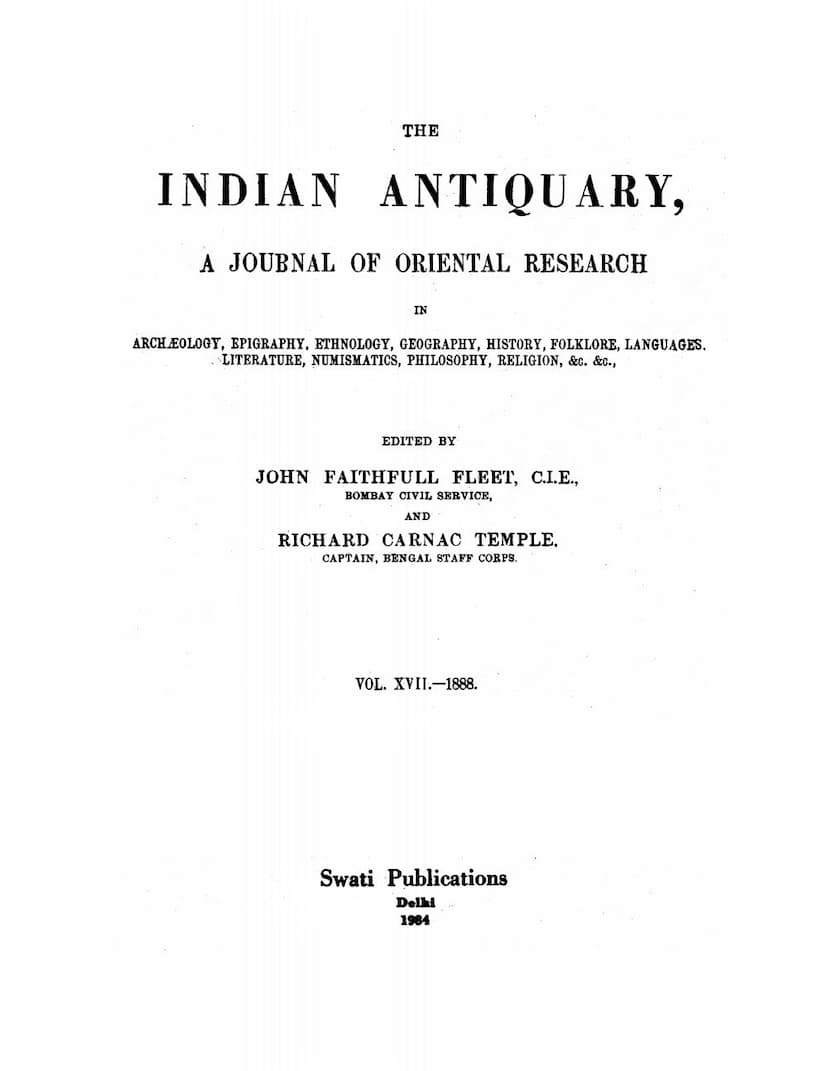Indian Antiquary Vol 17
Added to library: September 1, 2025

Summary
This volume of the Indian Antiquary, published in 1888, contains a rich collection of articles on various aspects of Oriental research, with a particular focus on Indian history, religion, and culture. While not exclusively a Jain text, it includes significant contributions related to Jain sacred literature. Here's a comprehensive summary of its content, highlighting the relevant aspects:
Overall Scope of the Indian Antiquary, Vol. XVII (1888):
The Indian Antiquary is a journal dedicated to Oriental research, covering archaeology, epigraphy, ethnology, geography, history, folklore, languages, literature, numismatics, philosophy, and religion. This particular volume, edited by John Faithfull Fleet and Captain Richard Carnac Temple, features contributions from a diverse range of scholars. The table of contents reveals a wide array of topics, from deciphering inscriptions and analyzing historical eras to exploring folklore and translating sacred texts.
Key Contributions Related to Jainism:
The most direct and significant contribution related to Jainism in this volume is:
- THE SACRED LITERATURE OF THE JAINS, TRANSLATED FROM THE GERMAN OF PROF. WEBER by Dr. H. W. Smyth, Baltimore, and THE SACRED LITERATURE OF THE JAINS by Prof. E. Weber, Berlin. (Pages 279, 339, and also mentioned in the contents).
This entry indicates a scholarly examination and translation of Jain sacred literature, likely an article or series of articles based on the work of Professor Weber, a prominent Indologist of the time. While the specific content of this translation is not detailed in the table of contents, its inclusion signifies the journal's interest in presenting the foundational texts of Jainism to a wider audience, making it accessible through scholarly analysis and translation. Such contributions would have been crucial for understanding Jain philosophy, history, and religious practices in the context of broader Indian civilization.
Other Relevant Contributions (Potentially of Interest to Jain Scholars):
While not directly about Jainism, several other articles touch upon subjects of interest to Jain scholars due to their coverage of ancient Indian chronology, literature, and religious practices:
- CALCULATIONS OF HINDU DATES: This recurring section, with multiple entries (Nos. 7-20) by J. F. Fleet, would likely deal with the complex systems of Indian chronology, including the Saka and Vikrama eras, which are also relevant for dating Jain inscriptions and texts. Understanding these chronological methods is vital for historical context.
- THE TWELVE-YEAR CYCLE OF JUPITER by Sh. B. Dikshit (Pages 1, 812): This article delves into Hindu astronomical and calendrical systems, which are interconnected with the dating methods used in Jainism and other Indian religions.
- SANSKRIT AND OLD-KANARESE INSCRIPTIONS: J. F. Fleet contributes several inscriptions, which, while not exclusively Jain, often contain references to religious practices, rulers, and social customs that provide broader historical and cultural context for Jainism in different regions and periods.
- FOLKLORE IN SALSETTE by Geo. F. D'Penha (Pages 50, 104, 202, 236) and FOLKLORE IN WESTERN INDIA by Putlibai D. H. Wadia (Pages 75, 128): These articles explore folk traditions, which often preserve ancient beliefs, customs, and stories that may have connections to or parallels with Jain narratives and practices.
- PROGRESS OF EUROPEAN SCHOLARSHIP: Several installments (Nos. 9, 10, 11) by G. A. Grierson and W. R. Morfill, covering reviews of various Orientalist publications. These would offer insights into the contemporary state of scholarship on Indian religions and literature.
- THE BAKSHALI MANUSCRIPT by Dr. A. F. Rudolf Hoernle (Pages 33, 399): This significant article analyzes a mathematical manuscript of great antiquity. While primarily mathematical, the context of such ancient Indian texts often intersects with the development of scientific and philosophical thought that also influenced Jainism.
- THE PROBABLE AGE OF SOME PALLAVA REMAINS by Dr. E. Hultzsch: This epigraphical study contributes to the understanding of South Indian history, a region where Jainism also had a significant presence.
In Summary:
While the "Indian Antiquary, Vol. XVII." (1888) is not a Jain text in itself, it is a crucial journal for historical and religious research in India. Its inclusion of "The Sacred Literature of the Jains" translated from Professor Weber's work highlights its commitment to presenting primary Jain texts and scholarly analyses. Furthermore, the volume's broader coverage of Indian chronology, folklore, and inscriptions provides valuable contextual information for understanding the historical and cultural landscape in which Jainism flourished. Scholars interested in the historical aspects of Jainism would find this volume a valuable resource for understanding the broader intellectual currents of 19th-century Oriental studies and the academic engagement with Jain traditions.